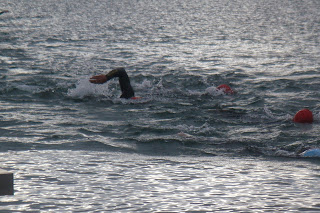 (1.2 mile open water swim PR, 26min. flat)
(1.2 mile open water swim PR, 26min. flat)Before we get started please note that I am not a "swimmer" I did not swim in high school or college. Actually I have only been swimming for about 2 years now and Lindsay for less than 6 months. Because of this we feel that what we lack in experience we MUST make up for with proper technique. Of the countless laps that we swim each week, I would estimate that at least 50% are dedicated to swimming slow with as close to perfect technique as possible. Swim slow to race fast!! This is not to say that the other half of our pool time is dedicated to shaving seconds off of our 100m. intervals. By establishing muscle memory 25 slow, controlled meters at a time we are able to swim with good technique at a fast pace naturally.
Here is the question. How do i get the most distance out of each stroke, while using the least amount of energy possible?? First things first, having someone on deck who can evaluate your stroke and even video tape makes a world of difference. Often times we are not aware of our deficiencies until they are pointed out by others. (I know I have a patchy beard... Thanks for pointing that out!) Things that your deck mate should make you aware of; 1. A low or sinking back half (this GREATLY increases your drag and makes your top half have to work harder.) Try using a pull buoy between your legs. Also concentrate on pushing your lungs down. Try to envision yourself swimming downhill. 2. The rotational axis of the body. Your shoulders should NOT be level with the waters surface. Many people think that it is there arms that propel them forward in the water, these are the same people that can't hit a baseball out of the infield. Much like swinging a bat, or throwing a punch, the majority of the energy should come from the hips where we are most powerful. By driving the hip downward, our torso and shoulders follow causing us to swim on our side. This action not only creates more force with less muscular contraction, it also significantly reduces the amount of drag created. So swim with your hips! 3. Point of hands entry into the water. The hand should not make a slapping action on the water but rather enter in a flat manor at a shallow angle. Imagine that your hand is a letter being inserted into a very narrow mail slot. Once in the water, don't begin your catch immediately, give your body (which should be on it's side) a split second of glide, then hitch your wrist slightly followed by your elbow. While this is taking place your opposite elbow is high. (see picture)
My suggestion is that these techniques should be practiced at a very low intensity, one length at a time with a 10-15 second recovery between each. That recovery time should be spent in an incredibly focused state of mind. Think about the strokes that were done correctly on the previous length and how you will make them even better on the next length. This can be done as an effective warm up and cool down, (about 10 lengths) similar to doing strides before and after a track workout.
When our newly increased oxygen economy is combined with our improved mechanical efficiency we are able to go further, faster, and with less fuel! Which you are going to need to hammer out that bike split!!!
No comments:
Post a Comment